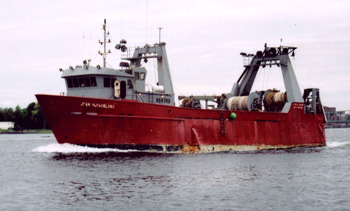Future of Dinosaurs
by Laurie Schreiber
|
Both herring and lobster fishermen expect that new conservation measures for the herring fishery could do exactly the opposite of what is intended and create serious shortages of bait for lobster fishermen.
“I think it will be interesting, to say the least,” said Al West, who works with the sardine cannery Stinson Seafood in Prospect Harbor, regarding availability of herring this summer. “I think it will be tough.”
A seasonal ban on midwater trawlers in inshore Gulf of Maine’s Area 1A, lower total allowable catch allocations, and new days-out provisions will result in bait shortages, predicted Dave Ellenton of Cape Seafoods in Gloucester, Mass. “We feel there will be shortages and prices will go up,” agreed Mary Beth Tooley of O’Hara Corp. and the Small Pelagics Group in Rockland. Robert Baines, a member of the Maine Lobstermen’s Association and owner of the fishing vessel Thrasher in South Thomaston, said his fishing co-op uses 500-550 bushels of bait per day in the summer; 90 percent of that is herring. With the new regulations, bait will be scarce at times, Baines predicted. “This season’s bait supply has me very concerned,” he said. In the meantime, industry representatives had some practical advice for lobster fishermen—they should salt or freeze as much herring as they can find and set it aside for the summer. The prospect of shortages will come as a shock to some because, said NEFMC fishery analyst Lori Steele, “We generally, overall, have a very healthy resource.” The problem, said fishermen, lies in the resource’s upcoming harvesting restrictions.
|

Midwater trawlers bring in most of the herring caught in the Gulf of Maine. At the Future of Herring in the GOM meeting at the Forum in Rockland there were four points that dominated the all day session. Trawler owners wanted access to more herring. Scientists want to consider the other fish that rely on herring. Lobstermen worry about which way to go on bait resources, and tuna and ground fishermen said too much of everything has already been taken out of the inshore Gulf by the highly efficient trawlers. Photo: Fishermen's Voice |
|
|
|
|
Great Idea Thrown Overboard
by Mike Crowe
|
In the days when this country had a wooden economy, before the oil economy we now have, an animal trap was likely made of wood. Native Americans were able to pick lobster off the beach at low tide, and didn’t need a trap. In Maine, European settlers didn’t catch lobster for food much before canning markets developed in the 1870’s. Soon after that lobster were not plentiful enough to pluck off the beach and so a wood trap was used.
Wooden traps remained the means, largely unchanged, for about 100 years. The mid 1970’s mark the visible beginning of the change to the wire mesh lobster trap. But about 20 years earlier, in 1957, a guy who had hand hauled lobster traps at the age of twelve, and to this day holds a lobster license in Massachusetts, got an idea for a wire mesh lobster trap. Not just a wire trap, but a plastic coated wire lobster trap.
Jim Knott, while setting wood traps from a row boat at Gloucester, learned the basics of wood traps. First, they were heavy, an early benefit of that was the upper body strength gained, which helped make him the captain of his school’s wrestling team. Having later considered the heaviness of the wet wood trap, the lower resistance of wire going through the water column and the durability of wire, a rigid wire mesh trap seemed a good idea. But metal in salt water would not have cut it without the last component. That was a new plastic, polyvinyl chloride (PVC), and it made all the difference. After getting out of the army in 1956, Jim and his brother started a business coating metal products in plastic-stethoscopes, plier handles, jumper cable handles, etc.
continue
|
| The company that lobster traps built. Out of appeciation for the lobster industry this weather vane was built for the top of the former clock tower of the 1840 mill in Northbridge, Massachusetts. Scythes were originally made there, before the plowshares to swords shift for the Civil War in the 1860’s, when it became a bayonet factory. It returned more to it’s roots in 1979 when Riverdale Mills rebuilt it for a lobster trap wire mesh factory. Photo: Fishermen's Voice |
|
|

